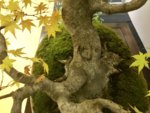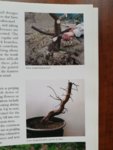D
Deleted member 21616
Guest
would anybody else be able to say whether trunk chopping is/was at all common in high level, let's say "kokufu-level" maples? I realize that most of those trunks were developed before most of us were born, with the developper long gone in most cases, but is there any record of how it was done 150-80 years ago?
these aren't the best examples, but i quickly attached 2 photos that Omiya posted (from the recent event) and 1 from kokufu 2018.
when i see trees like this, i struggle to reconcile what i see with my eyes with what appears to be a strong emphasis/concern with chopping and taper on this forum.
Above all, the tapering of these trunks is minimal, and none of the trees in this style seem to have been chopped.
With no slight intended, is chopping a 'western' practice? (i realize that it is done, today, in japan)
Or is it a practice for people in a relative hurry?
I am asking because i am not well-travelled when it comes to bonsai, and base myself on what I have seen at the Montreal bonsai collection and at local growers: some of the most impressive trees i have seen here in Montreal were never chopped: their trunks were given shape at a very young age, and by means of a fairly straightforward and risk-free cycle (growing out branches, removing them before they got too big, and re-growing other branches, remove those branches before they get to big, etc.) exceptional trunks with incredibly natural-looking taper and minimal scarring (if any) were developed over 15-to-40 years (depending on the tree).
I ask this question with full awareness that there are very many exceptional trees that have been grown by chopping.
I'm not even sure what question i'm asking here. I just thought it might be fun to hear everyone's thoughts on this
please include pictures in your posts if possible! pictures make the online world go round
these aren't the best examples, but i quickly attached 2 photos that Omiya posted (from the recent event) and 1 from kokufu 2018.
when i see trees like this, i struggle to reconcile what i see with my eyes with what appears to be a strong emphasis/concern with chopping and taper on this forum.
Above all, the tapering of these trunks is minimal, and none of the trees in this style seem to have been chopped.
With no slight intended, is chopping a 'western' practice? (i realize that it is done, today, in japan)
Or is it a practice for people in a relative hurry?
I am asking because i am not well-travelled when it comes to bonsai, and base myself on what I have seen at the Montreal bonsai collection and at local growers: some of the most impressive trees i have seen here in Montreal were never chopped: their trunks were given shape at a very young age, and by means of a fairly straightforward and risk-free cycle (growing out branches, removing them before they got too big, and re-growing other branches, remove those branches before they get to big, etc.) exceptional trunks with incredibly natural-looking taper and minimal scarring (if any) were developed over 15-to-40 years (depending on the tree).
I ask this question with full awareness that there are very many exceptional trees that have been grown by chopping.
I'm not even sure what question i'm asking here. I just thought it might be fun to hear everyone's thoughts on this
please include pictures in your posts if possible! pictures make the online world go round










